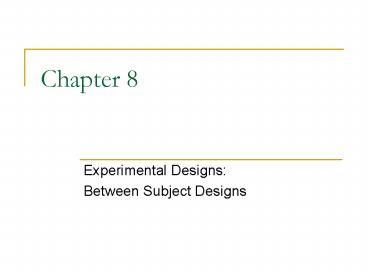Experimental Designs: PowerPoint PPT Presentation
1 / 14
Title: Experimental Designs:
1
Chapter 8
- Experimental Designs
- Between Subject Designs
2
Different Experimental Designs
- Between Subject Design Participants experience
only one level of the independent variable. The
variable is manipulated between subjects. - Within Subject Design All participants
experience all levels of the independent
variable. The variable is manipulated between
subjects. - Mixed Design An experiment with a mixture of
between subject and within subject variables.
3
Advantages and disadvantages of the between
subject design
- Advantage Time related threats to validity
(e.g., practice effects, fatigue, history) are of
no concern - Disadvantage Individual differences among the
participants can be a source of problems.
4
Individual Difference Variables (participant
variables)
People differ from one another. The ways the
differ are referred to as individual differences.
Examples include intelligence, age, gender.
5
Problems created by individual differences
- Individual differences can become confounding
variables - When individual differences are great, they can
mask differences between the conditions of the
experiment (i.e., differences caused by the
independent variable).
6
Methods for reducing the risk of confoundings by
individual differences
- Random assignment to conditions. The process
requires that each individual have an equal
chance of being assigned to each condition of the
experiment. - Restricted random assignment. Random assignment
with the restriction that all conditions have the
same number of participants - Matched groups. For each individual with a
particular set of characteristics (or set of
characteristics) assigned to one condition, a
comparable person with the same or similar
characteristics are assigned to the other
conditions - Restrict the range of individual differences.
7
The variability problem
When individual differences are great, the
variability among individuals (within groups
variability) can mask the difference between
conditions of the experiment (between groups
variability)
8
Minimizing the variability problem
- Standardize treatment procedures and settings
- Limit individual differences
- Increase sample size
9
The effect of sample size can be understood in
the context of statistics.
- Statistical analysis involves comparing the
difference among groups to the difference we
would expect because of error. - Our estimate of error is derived by looking at
the within group variability. - An increase in the sample size results in a
decrease in our estimate of error.
10
Threats to internal validity of between subject
designs
- Assignment bias When there is a confounding
involving an individual difference variable - Differential attrition More participants
dropout from one condition than another - Diffusion of treatment Participants in one
condition discover the treatment for another
condition - Compensatory equalization Participants in one
condition demand to be treated like participants
in other conditions.
11
Threats to internal validity contd.
- Compensatory rivalry Participants in one
condition are motivated to compete against
participants in another condition. - Resentful demoralization Participants in one
condition become demoralized by superiority of
other groups.
12
Two group vs. multi-group between subject designs
- Two group design Only two groups
- Advantage simplicity
- Disadvantage may not provide complete picture
- Multi-group design
- Advantage may provide a more complete picture
- Disadvantage Too many groups may mask effect of
independent variable
13
(No Transcript)
14
Statistical Analysis of Between Subject Designs
Data
Nominal or Ordinal
Interval or Ratio
X2 (Chi Square)
Two Groups
Multiple Groups
t test for independent groups
One way Analysis of Variance (F test)

